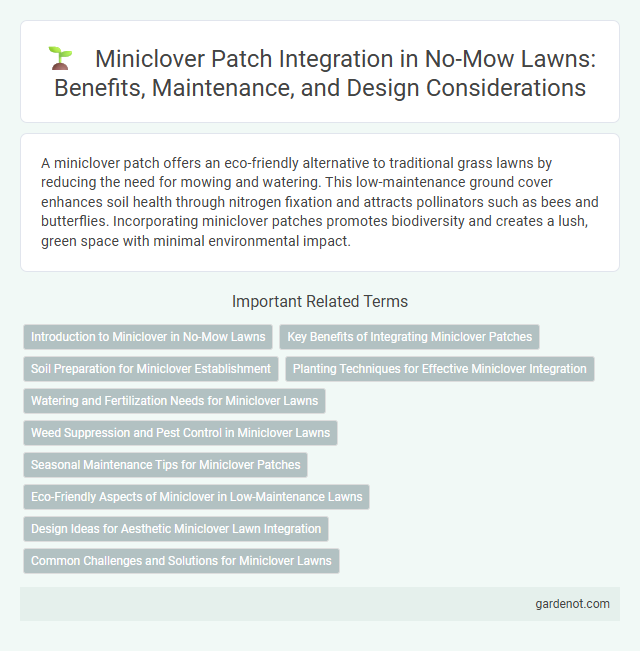A miniclover patch offers an eco-friendly alternative to traditional grass lawns by reducing the need for mowing and watering. This low-maintenance ground cover enhances soil health through nitrogen fixation and attracts pollinators such as bees and butterflies. Incorporating miniclover patches promotes biodiversity and creates a lush, green space with minimal environmental impact.
Introduction to Miniclover in No-Mow Lawns
Miniclover is a low-growing, nitrogen-fixing groundcover ideal for no-mow lawns, offering a sustainable alternative to traditional grass. Its dense foliage suppresses weeds and reduces water usage while maintaining a vibrant green appearance. Miniclover enhances soil health by naturally enriching nitrogen levels, promoting robust lawn vitality without frequent mowing.
Key Benefits of Integrating Miniclover Patches
Miniclover patches enhance no-mow lawns by naturally fixing nitrogen, reducing the need for synthetic fertilizers while promoting greener, healthier grass growth. Their dense growth habit suppresses weeds and improves soil structure, leading to lower maintenance and water requirements. Integrating Miniclover patches boosts biodiversity and creates a sustainable, resilient lawn ecosystem.
Soil Preparation for Miniclover Establishment
Soil preparation for Miniclover establishment involves thorough site assessment and pH adjustment to maintain optimal acidity levels between 6.0 and 7.0, ensuring nutrient availability. Incorporating organic matter such as compost improves soil structure, promotes moisture retention, and supports root development. Proper tilling to a depth of 4-6 inches creates a loose seedbed, facilitating seed-to-soil contact necessary for uniform germination and healthy Miniclover growth.
Planting Techniques for Effective Miniclover Integration
Plant Miniclover patches by first preparing the soil with light tilling to ensure proper seed-to-soil contact, enhancing germination rates. Scatter seeds evenly at a rate of 1 to 2 ounces per 100 square feet, then cover lightly with soil or mulch to retain moisture and protect the seeds. Regular watering during the first 2 to 3 weeks encourages strong root establishment, critical for Miniclover's successful integration into no-mow lawns.
Watering and Fertilization Needs for Miniclover Lawns
Miniclover lawns require minimal watering, thriving best with natural rainfall and only occasional supplemental irrigation during extended dry periods. Fertilization needs are low, as miniclover naturally fixes nitrogen in the soil, reducing the need for synthetic fertilizers and promoting sustainable lawn care. This results in a resilient, eco-friendly lawn that conserves water and minimizes chemical inputs.
Weed Suppression and Pest Control in Miniclover Lawns
Miniclover patches in no-mow lawns naturally suppress weed growth by forming a dense, low-growing ground cover that limits sunlight exposure to weed seeds, reducing their germination. The dense foliage also disrupts pest habitats, deterring common lawn pests such as grubs and aphids while promoting beneficial insects like ladybugs and pollinators. Incorporating miniclover enhances weed suppression and pest control, contributing to healthier, low-maintenance lawn ecosystems.
Seasonal Maintenance Tips for Miniclover Patches
Miniclover patches thrive with minimal mowing, recommended at 3 inches to promote healthy growth and prevent weeds. Seasonal maintenance includes light watering in dry periods and avoiding heavy fertilizer to support its nitrogen-fixing properties. Regular overseeding in early spring ensures dense coverage and resilience throughout the growing season.
Eco-Friendly Aspects of Miniclover in Low-Maintenance Lawns
Miniclover patch enhances eco-friendly low-maintenance lawns by fixing nitrogen naturally, reducing the need for synthetic fertilizers. Its dense growth suppresses weeds and requires minimal mowing, conserving water and lowering carbon emissions. This sustainable ground cover supports soil health and promotes biodiversity in residential landscapes.
Design Ideas for Aesthetic Miniclover Lawn Integration
Miniclover patches create a lush, green carpet that complements modern landscape designs by offering a low-maintenance alternative to traditional lawns. Integrate aromatic herbs and native wildflowers around the clover to enhance biodiversity and visual contrast while promoting sustainable gardening. Strategic placement near pathways or seating areas provides natural texture and color variation, elevating the overall aesthetic appeal of your outdoor space.
Common Challenges and Solutions for Miniclover Lawns
Miniclover lawns often face challenges such as uneven growth, weed invasion, and susceptibility to drought stress. Proper soil preparation, consistent watering, and periodic overseeding help maintain dense, healthy patches that resist weeds and recover quickly from dry conditions. Integrating organic fertilizers and mowing at the recommended height supports robust root development and enhances overall Miniclover lawn resilience.
Miniclover patch Infographic

 gardenot.com
gardenot.com